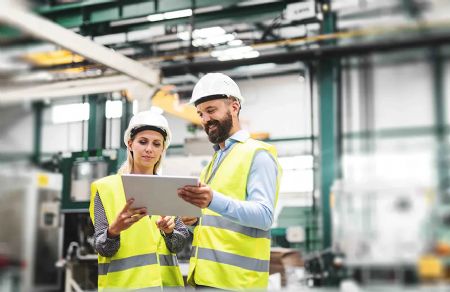
Artificial intelligence (AI) is no longer a futuristic concept in manufacturing — it is already reshaping operations on the factory floor. While much of the attention is focused on software platforms and data analytics, the machinery feeding these systems with data is just as critical. Chris Johnson, managing director of bearing specialist
SMB Bearings, believes that the road to the smart factory does not run solely through algorithms. He said: “It also depends on the bearings that keep production moving and supply AI with the data it needs to perform.”
Manufacturers are increasingly recognising that AI’s success hinges on the reliability of the machines it monitors. A survey by the
National Association of Manufacturers found that 72% of manufacturers have seen AI cut costs and boost efficiency. Yet, as Mr Johnson points out: “Software and algorithms cannot deliver results on their own — they depend on machines that run smoothly, efficiently and reliably.” When equipment fails or produces poor-quality data, the benefits of AI quickly evaporate.
Deloitte’s research supports this view, revealing that three quarters of manufacturers have ramped up investment in data lifecycle management to support AI adoption. However, nearly 70% still cite poor data quality and validation as their biggest challenge. Manufacturers are now prioritising high ROI use cases, but these can only succeed if built on solid operational foundations.
This is where machinery components, particularly bearings, come into play. Bearings may be among the smallest parts in a production system, but they are also some of the most vital. Without them, motors, conveyors, robots and pumps would grind to a halt. Increasingly, bearings are not just mechanical parts but intelligent components that provide the very data AI systems rely on.
Mr Johnson explained: “The essential function of a bearing is to support moving parts and reduce friction. In simple terms, they keep the machine turning. But in AI-driven factories, their role is much broader.” Bearings are often the first components to show signs of wear, making them natural indicators of a machine’s overall health. Even subtle changes — a rise in temperature, a shift in vibration, or a slight increase in noise — can signal stress. If ignored, these signs can escalate into overheating, misalignment or total failure.
Predictive maintenanceThis predictive potential is why bearings are central to AI-powered maintenance strategies. Rather than relying on rigid schedules or waiting for breakdowns, manufacturers can monitor bearing health to detect early warning signs. The National Association of Manufacturers report highlights predictive maintenance as one of the leading applications of AI in manufacturing, with over half of surveyed manufacturers citing it as a primary use case.
Traditionally, monitoring bearing health required external tools like handheld sensors or scheduled inspections. While these methods are still used, modern bearings are increasingly being designed with integrated sensors. These intelligent bearings can measure vibration, temperature, load and lubrication in real time, transforming them into active data sources.

Mr Johnson continued: “Instead of acting as a silent component, the bearing becomes a communicator. It shares its condition and helps the wider system understand how a machine is performing.”
For example, if a sensor detects a gradual increase in heat, AI can flag the likelihood of future failure, allowing engineers to intervene before production is disrupted. This integration is part of a broader trend where physical components become digital assets. Bearings contribute to the digital twin — a virtual model that mirrors the real machine’s condition. Given their constant movement and critical role, bearings provide some of the most valuable data for these systems.
intelligent bearingsThe impact of intelligent bearings is not just technical but financial. Unplanned downtime is one of the most expensive problems in manufacturing. A single hour of lost production in a high-volume plant can cost tens or even hundreds of thousands of pounds. Traditional maintenance methods rarely strike the right balance between reliability and cost-effectiveness.
With intelligent bearings, manufacturers can shift to predictive and even prescriptive maintenance. Predictive maintenance warns of impending issues, while prescriptive maintenance recommends the best course of action. Mr Johnson explained: “If a bearing shows unusual vibration, the AI system might suggest slowing down the machine temporarily to prevent further damage until a planned replacement can be made.”
This targeted approach reduces unnecessary part changes, optimises maintenance resources and minimises production interruptions. In essence, the bearing becomes a key player in maximising uptime.
Beyond maintenance, bearings also contribute to machine efficiency. By reducing friction, they help motors consume less energy and prevent overheating. When this performance data is analysed by AI, manufacturers gain insights into energy usage and potential improvements. If a production line is using more electricity than expected, bearing data can help pinpoint whether the issue lies in misalignment, lubrication or overloading.
As manufacturers face increasing pressure to meet sustainability targets, the role of these small components becomes more strategic. Bearings support lower power use and more consistent performance, aligning with both regulatory demands and customer expectations for ‘greener’ manufacturing.
Looking ahead, intelligent bearings will be central to the evolution of adaptive factories — systems that respond to changes in demand, material supply or environmental conditions with minimal human intervention. Mr Johnson concluded: “Machines must be able to sense their own condition and act on that information. Intelligent bearings already provide an example of this. By alerting systems to problems and suggesting actions, they contribute to machines that are not just automated but increasingly self-correcting.”